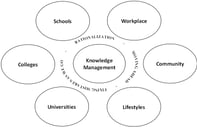Published on
Bringing Higher Education and the Corporate World Together

There is a lot of truth that can be said about one’s perception of corporate America and education. There is also the entrepreneur who is also in need of skills and more education. That being said, what can educators and institutions due to provide this level of support? What about global business and the ability to operate in this environment with all of the financial and economic challenges not forgetting the socio-economic changes that are ever present. Institutions need to be unique and offer their business model of courses that drive the next century but also need that level of support from the business community to get their graduates hired. This balancing act often sees many areas of gray and types of questionable based interactions when it comes to the decisions on classes and course deliverables.
The challenge according to Buford (1999) is we focus too much on the present and short range needs of corporate America as educators. Why won’t institutions look out 25 years and build advanced course offerings allowing the students that ability to step level to level in a more progressive fashion? This is essential for the returning adult student who needs more of a learning/practical application while also looking at the speed and abilities of the untested college student. According to Phillips (2012) unemployment also is driven by a group of individuals who are no longer getting unemployment and may have returned to their learning roots with getting additional education and augmenting their wallets with financial aid. According to Buford (1999) we also need to start applying distance learning into this progressive learning process. This idea in aggregate takes into consideration the current grades and learning attributes that the student demonstrates and requires the institutions that practice distance learning to build an infrastructure that is progressive based. This new application allows the gifted student to get more material in a challenging manner while addressing the slow learner’s needs. This balance teaches the same practices to both groups but allows for each to see success and learning at a pace that challenges and engages them. This process can also be utilized in the class with the addition of iPads and other tablets as custom learning and coursework will be altered as the grading and needs change. This also would take into consideration the learning curve and those trying to beat the system with periodic testing that places students at the levels needed to empower and engage their minds thus improving their retention and lower dropout rates.
There are a few points that corporations are becoming more vocal with and integrating this process:
- Corporations need to detail the needs 25 years in the future or project the potential needs.
- Institutions need to offer more custom learning options that are progressive and can be augmented to adapt to each style and level of learning with interactive and progressive testing as a way to solidify their capabilities.
- Culture changes from the institutions and corporations to be more realistic but also interactive in partnering for the future.
- Flexibility of the type and level of interaction between a distance, traditional and hybrid mode of learning environment.
- The ability for some advanced learning attributes to be interfaced with corporate operations as part of an annual performance and learning improvement process based around employees’ succession planning.
There are many changes that are being seen in the United States with European and Asian companies building g and expanding plants in various states. The newest entrant is Airbus in Alabama and with this new entrant there will be an influx of employment, money and educational needs to prepare and advance those who are working in the new facility. This also enables technology and planning to drive the need and not always the corporate demands that we see dictating some of the educational changes.
According to Phillips (2012) education is being changed not by the students but because of the economic drivers that require them to look at alternate revenue stream options. The author further details that several mid-level universities have changed their entire format based on the amount and level of interactions in a few corporate clients. This is to gain more of their business and also in the hopes to secure more companies as they piggyback on the work of others. This “selling out” question makes you think back to the basic needs of the four stakeholders involved:
- Institutions- a 50% increase in progressive and more self-paced learning options incorporating tablets and secondary advanced options in progressive learning.
- Small Business- a 75% increase in economical and budget savvy approaches to progressive learning while supporting the growth and future development rather than addressing the concerns of today.
- Progression-That a 42%change in flexibility regarding adaptation of these progressions to enable all levels and types of learning to get a more equaled and balanced approach.
- Communities-measuring through population growth and diversity-Seeing this learning environment drive more business with growth and the entrepreneurial spirit that was present 25 years ago with the means to accomplish the dreams and desires of those we educate.
The resources that we have available to us here are far greater than in other parts of the world. The spirit is what we need to balance the business based influences on today and plan curriculum for the future. There also has to be a balancing of the levels of learning to allow everyone the opportunity to absorb but yet apply their newly learned knowledge.
– – – –
References
Buford, Phyllis Scott. “THE LAST WORD: Corporate America’s Stake in Higher Education Diversity.” Black Issues in Higher Education 16.10 (1999): 128-. ProQuest Central. Web. 2 July 2012.
Eleena, d. L. (1993, Sep 10). Executive education (A special report): Payback — just for you: More corporations shun off-the-shelf courses in favor of custom-tailored ones. Wall Street Journal Page 5
Phillips, Jim. “Are Research Universities Selling Out? Series: The Changing Role of Research in Higher Education.” Austin American Statesman: A.1. ProQuest Central. Jan 14 1996. Web. 2 July 2012 .
Author Perspective: Educator



